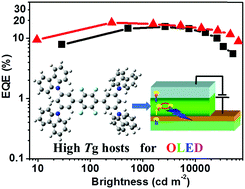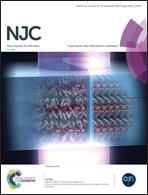New tetrafluorophenylene/carbazole hybrid host materials for phosphorescence organic light-emitting diodes
Abstract
Two novel carbazole based compounds, namely 9,9′,9′′,9′′′-(2′,3′,5′,6′-tetrafluoro-[1,1′:4′,1′′-terphenyl]-3,3′′,5,5′′-tetrayl)tetrakis(9H-carbazole) (CzF) and 9,9′,9′′,9′′′-(2′,3′,5′,6′-tetrafluoro-[1,1′:4′,1′′-terphenyl]-3,3′′,5,5′′-tetrayl)tetrakis(3,6-di-tert-butyl-9H-carbazole) (TCzF), were designed and synthesized for application as host materials in phosphorescence organic light-emitting diodes (OLEDs). Tetrafluorophenylene was selected as the linking bridge to tune the photophysical and optoelectronic properties of these two compounds. Extremely high glass transition temperatures of 198 °C and 330 °C were detected for them. Green phosphorescence OLEDs were fabricated by vacuum evaporation using CzF and TCzF as hosts and tris[2-phenylpyridinato-C2,N] iridium(III) (Ir(ppy)3) as a doped emitter. Good performance was obtained with a maximum current efficiency of 66.3 cd A−1 (corresponding to an external quantum efficiency of 18.3% and a power efficiency of 46.24 lm W−1) for the CzF hosted device. TCzF exhibited an inferior performance relative to CzF, which was attributed to the presence of insulating tert-butyl groups on the surface of TCzF.



 Please wait while we load your content...
Please wait while we load your content...